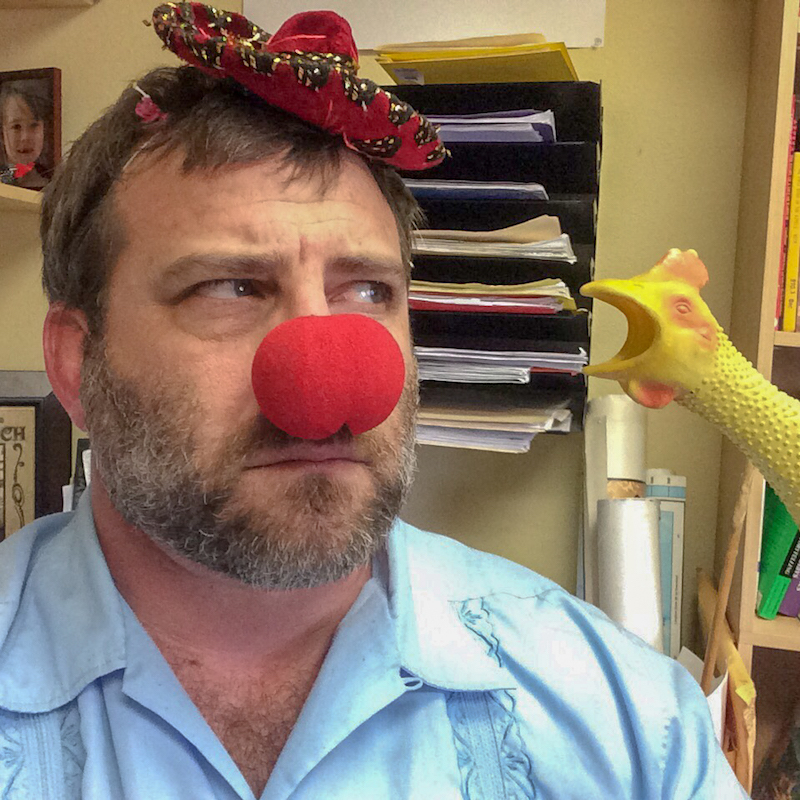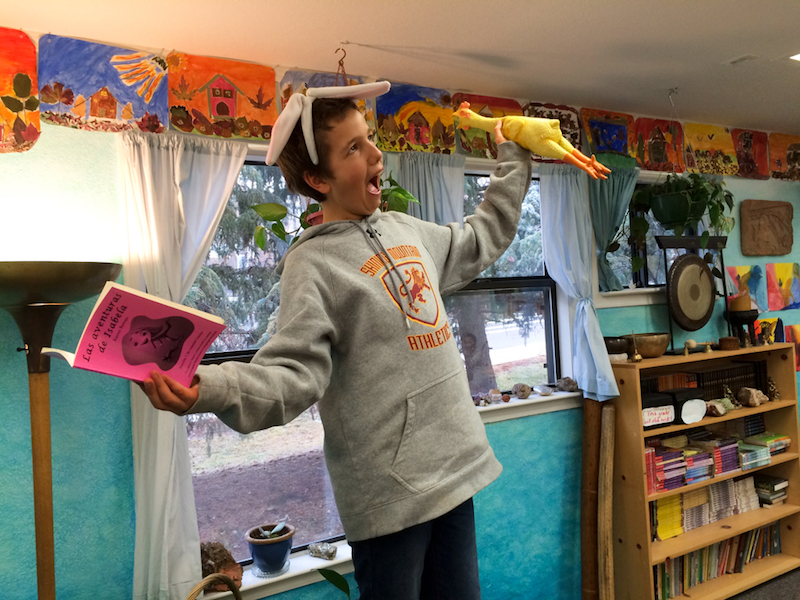By Joshua Berman
I walk into the brightly colored 3rd grade classroom, where the children are already seated, with my guitar case slung over one shoulder and a covered basket of props in my hand. A few items are strategically overflowing and students try to catch a glimpse of what’s inside—today, a chef’s hat, a rubber chicken, and a bunch of rubber grapes are partially visible. The children strain their necks to see, already excited about the lesson—before I’ve even greeted them with a boisterous, “Buenos días, clase!”
“Buenos días, don Josué!” they respond, rising to their feet in unison to begin the lesson with a predictable series of repetitive verses, movements, and song.
What’s in my basket?
I teach Spanish to grades 1 through 8 at Shining Mountain Waldorf School in Boulder, Colorado. Over the past 10 years, I have put my curriculum together by consulting and meeting with my colleagues at other Waldorf schools and by studying current trends in World Language teaching in other schools as well. As a result, my classes are a blend of the most effective techniques that I’ve found; they are also a far cry from the strict regimen of worksheets, conjugations, and text books that I remember dominating my middle school French classes.
Today, I will rely more on the power of story than the rules of grammar to maximize the precious forty minutes I have with each class. The students are still eyeing my basket, wondering what the tale will be about today. Perhaps my rubber chicken only has 17 green grapes and he is sad because—obviously!—he wants 23 purple grapes. “O no! O no! O Me o My!” shout my students in unison, as I’ve taught them to do whenever one of our characters encounters a problema. Maybe I’ll pull one of the students to the front of the room and put the chef’s hat on her so she can cook (or paint or buy or plant, depending on which verb I want to teach today) more grapes. For the rest of class, I’ll use only phrases in Spanish that they understand, in both questions and answers, as our story builds. That way, instead of teaching rigid present-tense conjugated verb forms (for “cook,” “paint,” “buy,” or “plant”), we just use them in the story.
Comprehensible Input or TPRS (Teaching Proficiency through Reading and Storytelling)
I’m using something called Comprehensible Input (or just “CI”). In my teaching career, CI is a broader movement that grew from something called “TPRS,” for “Teaching Proficiency through Reading and Storytelling.” Over the last decade or so, CI has had a somewhat revolutionary rise among world language teachers—in all languages, at all levels, all over the world.
The method aligns well with the Waldorf curriculum because it treats language like the right-brain, intuitive, poetic function that it is, rather than the analytical, scientific approach which many language teachers have tried to use since the 1960s.
[Related article: “Waldorf Schools and TPRS” by Chris Stolz]
“Language is not something you can teach”
“Language is not something you can teach,” said Carol Gaab, one of the leading teachers of CI, who is based in Colorado, at a recent Colorado Congress of Foreign Language Teachers in Loveland, CO; she explained, “it is not simply knowledge you can pass on to your students [like science or history]. Rather, it is something for which you can provide your students opportunities to interact in.”
In fact, calling CI a “strategy, a technique, or a methodology” is misleading, because it is nothing more than what it says it is—language that is understood. Period. Linguistics expert Dr. Stephen Krashen adds: “Language is acquired through comprehensible input. It is an unconscious process that happens when the learner is focused on the message, rather than the language itself.”
Dr. Krashen continues: “Acquisition requires meaningful interaction in the target language—natural communication—in which speakers are concerned not with the form of their utterances but with the messages they are conveying and understanding … The best methods are therefore those that supply ‘comprehensible input’ in low anxiety situations, containing messages that students really want to hear.”
Which, of course, is where the fun part comes in—the chicken, the hat, the grapes, or anything else from my closet full of props, puppets, and tools. We tell stories, we make up songs, we play games, create classroom rules—we do it all together, as much in the target language as possible, and I try to work in as many repetitions as I can, to make sure students understand the meaning of what they are hearing and reading. For different styles of learning, we change the pace and the activities, and I make sure the students let me know when they don’t understand something.
Traditional vertical lists of vocabulary, verb conjugations, and worksheets occasionally still make an appearance in my classes, especially in the middle school when the students sometimes crave rules, form, and grammar. But we don’t rely on those things anymore. We focus on comprehensible input and having so much fun that students don’t realize they are acquiring language.
Eventually, our sad rubber chicken travels to Moscow, goes to a fancy Russian grape store, and buys exactly what he wants: 117 neon yellow grapes which only cost $42.37—what a bargain! Now he is happy and so are the students, who are surprised that class is already over.
—Joshua Berman is a Spanish teacher for grades 1-8 at Shining Mountain Waldorf School, and a freelance writer. His website is https://joshuaberman.net.



